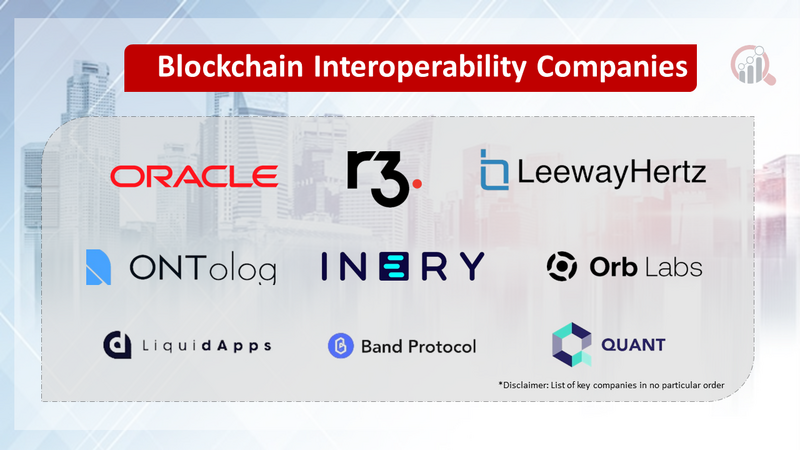Top Industry Leaders in the Blockchain Interoperability Market

Competitive Landscape of the Blockchain Interoperability Market
The blockchain interoperability market, poised for explosive growth at a CAGR of 27.2% from 2023 to 2028, is witnessing intense competition as players scramble to bridge the fragmented landscape of disparate blockchain ecosystems. This report delves into the key players, their strategies, and factors dictating market share, along with emerging companies and current investment trends.
Key Players:
Oracle Corporation
R3
LeewayHertz
Ontology
INERY PTE. LTD.
Datachain, Inc.
Quant Network Limited
Band protocol
LiquidApps
Orb Labs.
Strategies Adopted by Key Players:
- Cosmos Network: Focuses on modularity and interoperability, attracting developers with its Inter-Blockchain Communication (IBC) protocol.
- Polkadot: Employs a novel sharded architecture with a central relay chain facilitating cross-chain communication for independent blockchains.
- Chainlink: Provides a decentralized oracle network for connecting smart contracts to real-world data and off-chain resources.
- Hyperledger Fabric: Backed by the Linux Foundation, Fabric offers modularity and customization for enterprise blockchain solutions.
- Wanchain: Pioneers a privacy-preserving interoperability protocol, enabling secure cross-chain transactions.
Strategies for Gaining Market Share:
- Technology Innovation: Developing robust and scalable interoperability solutions, embracing emerging technologies like quantum computing.
- Ecosystem Building: Fostering developer communities, attracting dApp projects, and integrating with existing blockchain platforms.
- Standardization Adoption: Advocating for and adhering to interoperability standards like IBC and Cosmos SDK.
- Partnerships and Acquisitions: Collaborating with industry leaders and acquiring complementary technologies to expand reach and offerings.
Factors for Market Share Analysis:
- Supported Blockchains: The number and diversity of blockchains a solution interoperates with.
- Transaction Speed and Fees: Efficiency and cost-effectiveness of cross-chain transactions.
- Security and Privacy: Robustness against hacking and ensuring user data confidentiality.
- Ease of Use: Developer-friendly tools and APIs for building interoperable applications.
- Community and Support: Active developer communities and responsive technical support teams.
New and Emerging Companies:
- LayerZero: A novel protocol enabling seamless communication across diverse blockchains without relying on central hubs.
- Hop Protocol: Facilitates cross-chain liquidity aggregation and efficient asset movement.
- Multichain: A user-friendly interface for cross-chain swaps and asset transfers.
- Celer Network: Focuses on off-chain state channels for faster and cheaper cross-chain transactions.
Current Investment Trends:
- Venture Capital: Increasing investment in interoperability solutions, with a focus on Layer 2 protocols and privacy-preserving technologies.
- Strategic Partnerships: Collaborations between established players and emerging companies to accelerate interoperability adoption.
- Enterprise Adoption: Growing interest from enterprises seeking to leverage blockchain technology across diverse ecosystems.
Latest Company Updates:
October 2023- Vodafone’s Digital Asset Broker (DAB) recently announced the completion of proof of concept (or PoC) collaboration with Sumitomo Corporation, Chainlink Labs and InnoWave. The goal of the PoC was to enable cross-blockchain interoperability for a digital bill of lading. Vodafone's DAB leveraged Chainlink's Cross Chain Interoperability Protocol (CCIP) to facilitate the PoC. The CCIP enables communication between both permissionless and permissioned blockchains via a decentralized network - the same approach that was recently utilized in a proof of concept conducted by Swift focused on tokenization.
August 2023- SWIFT recently announced the results of a blockchain interoperability trial it conducted with over a dozen financial institutions including BNP Paribas, Citi, and DTCC. The trial utilized a combination of SWIFT's messaging platform and Chainlink's Cross-Chain Interoperability Protocol to integrate legacy systems with a public Ethereum test network and Avalanche blockchain. The goal of SWIFT's experiment was to demonstrate its potential to serve as a centralized connectivity provider, allowing financial institutions to leverage their existing SWIFT messaging infrastructure to interact with multiple blockchains. SWIFT stated that its trusted and secure existing infrastructure could act as a central bridge, eliminating a major obstacle in the development of tokenization and unlocking its potential. Given that tokenization platforms are still emerging, a more gradual transition from legacy to new systems will likely be needed. SWIFT messaging could play a key role in this transition.
June 2023- Adhara has launched a new blockchain interoperability lab called Harmonia with Hyperledger. Harmonia, a Hyperledger Lab, aims to facilitate cross-chain atomic settlement for institutional financial transactions. This means that either both sides of a transaction will succeed or fail together. A key objective is for this process to be decentralized without relying on an intermediary.












